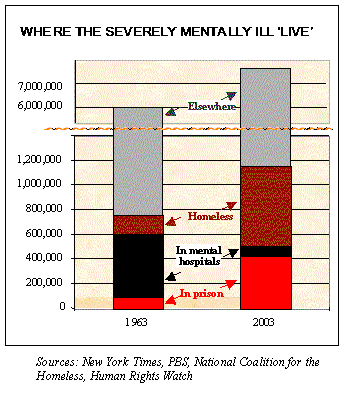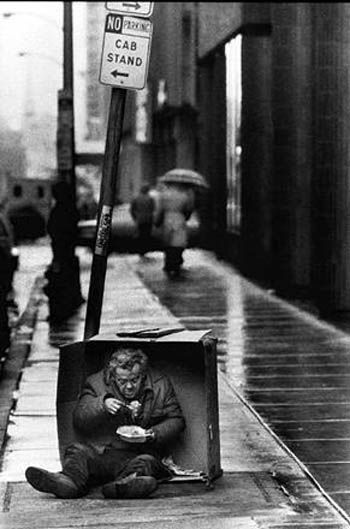Energy Awareness Course
Use CureZone kode to get a free session!
Lugol’s Iodine Free S&H
J.Crow’s® Lugol’s Iodine Solution. Restore lost reserves.
Original Dr. Hulda Clark
Hulda Clark Cleanses
Energy Awareness Course
Use CureZone kode to get a free session!
Lugol’s Iodine Free S&H
J.Crow’s® Lugol’s Iodine Solution. Restore lost reserves.
Original Dr. Hulda Clark
Hulda Clark Cleanses
Conservative Right of Passage from Blue to Red
Advertisement
Pro Dentim
A unique blend of 3.5 billion probiotic strains and nutrients backed by clinical research.
Pro Dentim
A unique blend of 3.5 billion probiotic strains and nutrients backed by clinical research.
100 homeless people die in my city every year. They are the forgotten fodder of Conservative ideologues. As a perfectly healthy hard working conservative, I listened as my pastors and friends told me that the homeless deserved or wanted to be homeless. There was some dissonance in my spirit about that but I came to believe the same thing. I had an uncle who, when a child was kicked in the head by mule. He went to a facility for the mentally ill where they fed him and gave him things to do during the day. He had clean sheets and a place to lay his head. Reagan changed my uncle's world. He was let out of the facility and a man with an intelligence of a immature toffler tried to find his way but ended up in jail most of the time for stealing a pack of cigarettes or a candy bar when he was hungry. Much like the Danish rite of passage, where the Danish young men kill dolphins that come into their waters, conservatives kill or sacrifice thousands of mentally ill homeless every year in their war against those in poverty. I only had empathy for the homeless after I became homeless following a car accident. With no insurance and a reiijured neck... my family abandoned me as... I became homeless... It is hard to empathize with the ugly homeless until you yourself become one.
June 11, 2004
Home19
Reagan and the Homeless Epidemic in America
Reagan’s budget cuts and overhaul of tax codes led to an explosion of homelessness in the U.S. during his 8 years in power. We speak with Carol Fennelly, a leading activist on homeless issues during the Reagan presidency. [Includes transcript]

More…
Throughout the week, Ronald Reagan has been praised almost non-stop on television, in newspapers and in magazines. Politicians and pundits from both establishment political parties have been practically falling over each other to heap praise on Reagan. And as he is glorified for what are termed his accomplishments and legacy, there is one term that was rose to prominence during Reagan’s time in power that is seldom mentioned. That is “homelessness.”
In fact many homeless rights activists say the single most devastating thing Reagan did to create homelessness was when he cut the budget for the Department of Housing and Urban Development by three-quarters, from $32 billion in 1981 to $7.5 billion by 1988. The department was the main governmental supporter of subsidized housing for the poor. Add this to Reagan’s overhaul of tax codes to reduce incentives for private developers to create low-income homes and you had a major crisis for low-income families and individuals. Under Reagan, the number of people living beneath the federal poverty line rose from 24.5 million in 1978 to 32.5 million in 1988.
And the number of homeless people went from something so little it wasn’t even written about widely in the late 1970s to more than 2 million when Reagan left office. But as Reagan proudly declared that the number of homeless shelters had increased significantly during his presidency, the homeless epidemic did not go ignored by everyone, especially not in Reagan’s back yard in Washington DC. Homeless rights activist Mitch Snyder and a dedicated group of homeless people and activists waged a many year campaign to win rights for people forced to live on the streets. Ultimately, they formed a movement based at what came to be known as the Community for Creative Non-Violence or CCNV. We are joined now by one of the people who was a leader of the homeless rights movement at CCNV during the Reagan years.
* Carol Fennelly, was a leading activist on homeless issues during the Reagan presidency. Along with Mitch Snyder, she was instrumental in establishing the Community for Creative Non-Violence in Washington DC. She is currently the Director of Hope House in Washington.
AMY GOODMAN: Carol Fennelly. We welcome you as well to Democracy Now!.
CAROL FENNELLY: Thank you.
AMY GOODMAN: Can you describe these years?
CAROL FENNELLY: You know, I remember the month that Ronald Reagan was inaugurated president. Our soup line, which would grow from the beginning of the month to a short line, to a large line by the end of the month, and then it would drop down when people got their small checks or whatever. At the first part of the month, it could get small again and grow up through the end of the month. But that first month, it was almost as if there was some cosmic energy out there, you know, telling us what was coming in the future, but the first of the month rolled around and the line didn’t get shorter. It stayed the same. It grew and grew and grew and the soup lines just went around the block in those years. I mean it, was a very difficult time. There were not enough services. We were literally claiming people off streets who had frozen to death in Detroit and, you know, in the industrialized states like Michigan. People who were out of work went into double digit unemployment. There were around Houston, there was a tent city of homeless people, most of whom had come from the Midwestern, you know, states like Michigan. They were looking for work. They called them black tag people, because back then, Detroit had black license plates and they would pack up their families and go to Texas looking for work in the oil fields. It was a scene out of the depression. I mean, what people fail to 1q1remember is that we were in a massive recession during the early 1980s. People were out of work. People were homeless. When we hear about this great economic, you know, victory that Ronald Reagan had in the 1980s, I think, who wrote that history, because I wasn’t there.
AMY GOODMAN: At the same time, that the conditions you describe were intensifying, there is also a resistance movement that you are a part of. What did you do?
CAROL FENNELLY: We went on fasts, hunger strikes for months at a time. We went to jail a lot. You know, we built a Reaganville in Lafayette Park, and homeless people stayed in Reaganville for the whole winter one year. We ended up actually finally passing homeless legislation, the McKinney Act, that is still around. It was a huge victory for homeless people back in the mid to late middle 1980s. And, you know, it—there were great victories for us as well. But it cost us with our health and freedom as any social movement costs people who are active in it.
AMY GOODMAN: Can you tell the story of the rats?
CAROL FENNELLY: The rats. We were—actually, the rats were—there was someone who was living with us who used to collect rats out of the alley and go release them on the White House lawn on a regular basis. The other story there, though, is the cockroaches, which we released in the White House dining room. You know, we collected them and—you know, in our neighborhoods because we lived in a very poor neighborhood, that was overrun by rats and roaches, and we selected them and got on their White House tour line and went through and released them in the White House dining room. The message was that in the event of a nuclear attack, the only people left would be only—the only creatures left would be the cockroaches. We thought we should introduce them to some of their new housing.
AMY GOODMAN: We’re talking to Carol Fennelly of the C.C.N.V., the Community for Creative Non-Violence and Reverend Hagler. We’ll be joined by Francis Fox Piven and Dolores Huerta. We’re a talking about race and class and homelessness in the 1980s. Carol Fennelly, your final thoughts?
CAROL FENNELLY: You know, the city—I’m in Washington, too. And the city has been completely disrupted by this, you know, three-day grief glut we’re going through. I thought it was completely appropriate that President Reagan would be brought into town on Wednesday at rush hour. We do a teleconference program out of our office where kids can talk to their fathers in prison. We couldn’t get the kids to talk to their dads because the whole downtown was shut down. I thought the arrogance of that was so appropriate, because that’s what they did when they were here, you know. Completely oblivious to the needs of the people in this community and by extension, I think, the rest of the country.
AMY GOODMAN: I want to thank you all for being with us, Carol Fennelly, leading activist on homeless issues during the Reagan presidency.



It has become the right of passage in a Democracy to let mentally ill or very low I.Q. homeless die on the streets of our cities. Do they really want to die in cardboard boxes or lying under a bridge? Reagan is the hero of conservatives for finally labeling what is truly evil. The poor are evil. The war against the poor and powerless was started by Reagan and all of thee mentally ill and low IQ human beings of the earth. After civil rights legislation made it illegal to openly hate black people....It finally became okay to hate the homeless... So do your part to oppose conservative's right of passage into adulthood by internalizing the fact that "But for the grace of God, there go I."Only when I was humbled into becoming homeless did I learn to empathize with those who are homeless. Of all of the losses a human being could suffer, I believe losing empathy and compassion for others would be the greatest loss of all. Before you judge those in the pictures above, walk a mile in their shoes... If you are a conservative who has no empathy and supports Reagan's war against the poor... I hope for you to learn the lessons of compassion and empathy without having to go the route that I have gone...
rudito con amor
More
This Forum message belongs to a larger discussion thread. See the complete thread below. You can reply to this message!
-
Expand this whole thread (8 messages)
Conservative Right of Passage from Blue to Red rudenski
17 y
1,353
rudenski
17 y
1,353
This is the position of the above message within the thread.
- Fiction and leftist hate filled propaganda! Yes Ro... #94312 17 y 1,318
- Your message summons a feeling of compassion from ... traderdrew 17 y 1,210
- You must’ve been going to the wrong church! ... #4256 17 y 1,257
CureZone Newsletter is distributed in partnership with https://www.netatlantic.com
Contact Us - Advertise - Stats
Copyright 1999 - 2025 www.curezone.org
0.148 sec, (6)


